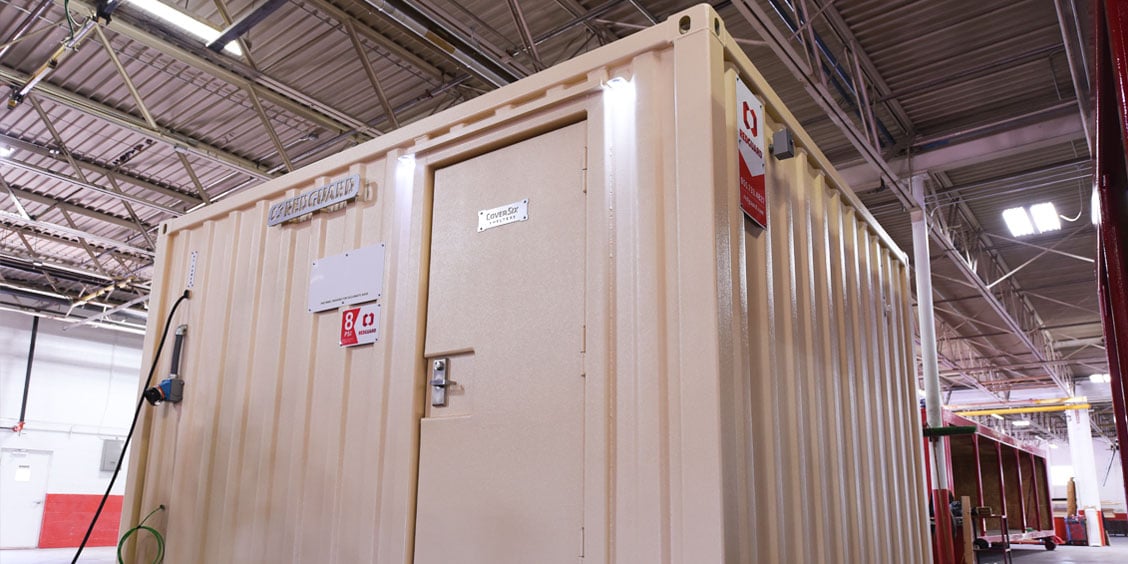
If you’ve ever wondered what makes a building blast-resistant, and what that even means, you’ve come to the right place. At CoverSix, our roots are in blast-resistant structures. As part of RedGuard, a leader in the design and manufacture of blast-resistant buildings, we've built our share of blast-resistant buildings. CoverSix was born out of a need for those buildings and other safe structures within the government, military and defense/security sectors.
We’ve compiled this "Intro to Blast-Resistant Buildings," based on the countless conversations we’ve had with customers over the years, along with our expertise as one of the world leaders in the production of blast-resistant buildings. We hope to answer your most nagging questions and provide you with the fundamental knowledge needed to make a smart purchasing decision.
First things first. While it may seem self-explanatory, there is a lot of confusion surrounding exactly what a blast-resistant building is and what it is not. A blast-resistant building is a structure that has been designed to withstand significant blast events.
Sometimes these structures are referred to as blast-resistant modules, blast-resistant units, or simply as a BRB or BRM, but one thing they’re not are “blast-proof” buildings.
The term “blast-proof” suggests that a building is 100% impermeable to a blast of any size or nature. Unfortunately, that just doesn’t exist. That’s why reputable manufacturers prefer to use the term “blast-resistant.” Blast-resistant implies that a building can withstand the force of a blast and provide a level of protection that will give anyone inside a chance to escape to a safer location.
Blast-resistant buildings can dissipate the pressure of a blast wave to protect the individuals inside.
Like many things, the true strength of a blast-resistant building doesn’t hinge on just one thing, but rather the sum of numerous parts and processes.
The following are just some of the critical components that go into constructing blast-resistant buildings at CoverSix.
Keeping with the anatomy theme, the core of any good blast-resistant building is its frame, and, at CoverSix, our frame is an all-steel structure we affectionately call the “ribcage.” Composed of six-inch steel c-channels spaced no more than 12 inches apart, our ribcage acts like that found within a human body. It provides a rigid frame to absorb pressure and protect all of the vital organs (or, in our case, people) contained within.
In many ways, our ribcage is like the crumple zones found within cars that are specifically designed to move in certain areas in order to protect others.
Once again, the keyword here is steel. As the building material with the highest strength-to-weight ratio, steel has both high compressive (top-down) and tensile (side-to-side) strength, making it perfect for blast-resistant buildings. Additionally, we use steel to fabricate our exterior walls because of its dynamic load transfer properties, also known as flex. Flex is the technical term for how steel behaves when hit by a shock wave.
In RedGuard's blast-test video, the same results we base our designs off of, you will barely notice any movement following the detonation of the explosion thanks to a combination of frame design, vertical stiffeners, and the way the steel walls bend and retract. In short, thanks to its construction—and materials—the building can absorb the impact of an explosion without permanently distorting its shape.
A structure is only as strong as its weakest link, and in many cases, that is its exterior door. At CoverSix, our exterior doors are subjected to the same standards as the rest of our buildings. The result is that our doors offer the same strength and protection as the steel wall it’s on.
While blast-resistant buildings are primarily designed for protection, that doesn’t mean that comfort and aesthetics are left out. Thankfully, in recent years, improved design processes and the availability of high-strength, blast-resistant glass have enabled manufacturers to install windows in blast-resistant buildings. This addition vastly improves the functionality of modules used for control, security, and offices space.
Even in the most basic blast-resistant building, there are overhead door lights, electrical disconnects, HVAC components, and communications equipment. Each interior fixture included in a finished building must be carefully specified in design to avoid becoming projectiles during an explosion.
During an explosion, the distance from the center of the blast determines the extent of shockwave damage. That is why we design our buildings to have the most important asset as far from the potential blast as possible. For example, if we were planning a multi-purpose building, we would have all the conferencing facilities located toward the rear of the building to ensure that occupants would have a safe place to gather in the case of the threat of a blast.
The design phase of any blast-resistant building needs to be an interactive process between the manufacturer and the client. Doing so will mean that whoever is designing your building will understand your unique needs and develop technically feasible solutions that will work for you and your team while keeping you safe.
Blast-resistant modular buildings are used in a variety of industries like petrochemical and offshore drilling operations, military installations, and even private or government security. These buildings can be transformed into virtually anything you can imagine, including offices, conference rooms, kitchenettes, locker rooms, and equipment storage facilities.
At CoverSix, since we primarily deal with defense contractors and law enforcement, one of the most popular requests we get is for viewing bunkers. These unique buildings feature a long expanse of blast-resistant windows where personnel can safely observe training operations utilizing grenades, IEDs, and those conducted on bombing ranges.
The important things to take away from this post are:
If you have questions about another aspect of blast-resistant buildings that we didn’t cover in this post, feel free to reach out. We’ll be happy to share our knowledge with you.